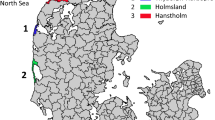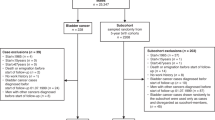Abstract
The effects of various factors were evaluated on both relative risk (multiplicative model), and absolute excess risk (additive model) of bladder cancer among 664 workers of a dyestuff factory in Northern Italy. These workers were exposed to aromatic amines in fairly constant working conditions from 1922 to 1970, and were employed for at least one year. They were followed up till the end of 1981 for a total of 12,302 man-years at risk. Under both models, the risk was greater for workers directly involved in aromatic amine manufacture than for those with only intermittent exposure. There was no marked effect of age at first exposure on the absolute excess risk of bladder cancer, but the relative risk was strongly and negatively related to age at first exposure. Under the multistage theory of carcinogenesis, this pattern of risk indicates an early stage effect. Absolute excess risk increased sharply during exposure, and continued to rise, although less sharply, after exposure had ceased. Relative risk, however, decreased after cessation of exposure, indicating a possible late stage effect. Thus, the results derived from both additive and multiplicative models are not in contrast when interpreted in terms of the multistage theory of carcinogenesis, though they are not totally consistent with a single-stage effect, either early or late. Aromatic amines may act on a stage somewhere between the first and penultimate, or on more than one stage of the process of carcinogenesis. Alternatively, it is possible that imprecision in the job classification or other observational problems may obscure the trends, or produce fictitious trends in the effects of variables such as age at first exposure and time since last exposure. Finally, such a pattern of trends could emerge if there were only two stages and the first and penultimate stage were the same.
This is a preview of subscription content, access via your institution
Access options
Subscribe to this journal
Receive 24 print issues and online access
$259.00 per year
only $10.79 per issue
Buy this article
- Purchase on Springer Link
- Instant access to full article PDF
Prices may be subject to local taxes which are calculated during checkout
Similar content being viewed by others
Rights and permissions
About this article
Cite this article
Decarli, A., Peto, J., Piolatto, G. et al. Bladder cancer mortality of workers exposed to aromatic amines: Analysis of models of carcinogenesis. Br J Cancer 51, 707–712 (1985). https://doi.org/10.1038/bjc.1985.106
Issue Date:
DOI: https://doi.org/10.1038/bjc.1985.106
This article is cited by
-
Medical follow-up for workers exposed to bladder carcinogens: the French evidence-based and pragmatic statement
BMC Public Health (2014)
-
Bladder cancer and black tobacco cigarette smoking
European Journal of Epidemiology (1994)



